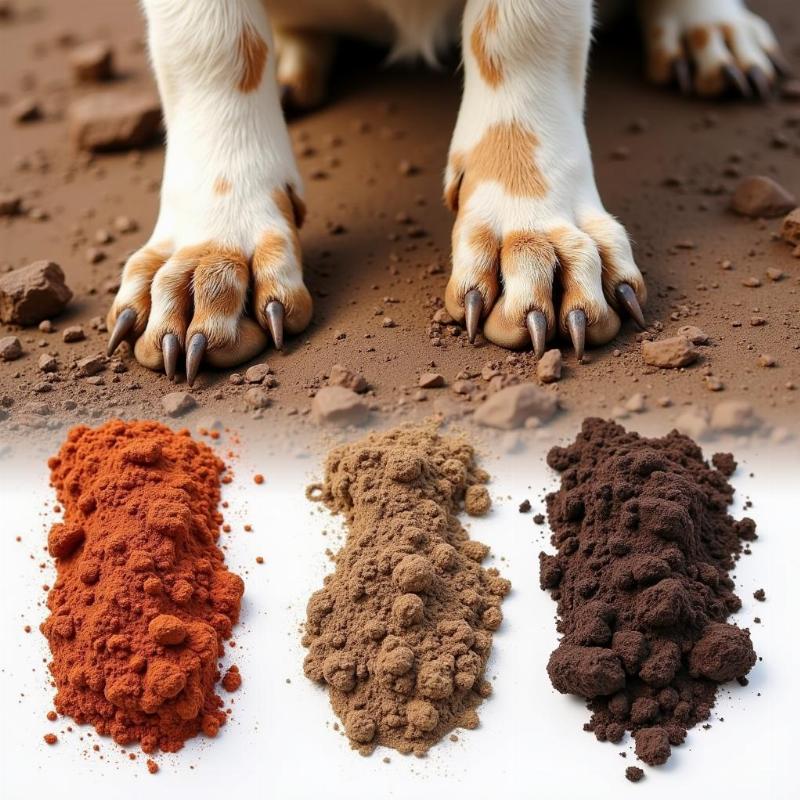Brown stains on your dog’s paws can be unsightly and sometimes indicate an underlying health issue. This comprehensive guide will help you understand the causes of these stains, provide effective removal methods, and offer preventative tips for keeping your dog’s paws pristine. We’ll cover everything from identifying the source of the discoloration to implementing long-term solutions.
Understanding the Causes of Brown Paw Stains
Several factors contribute to brown staining on dog paws. Identifying the root cause is crucial for effective treatment and prevention. Is it simply environmental discoloration from mud and dirt, or could it be something more? Let’s delve into the possibilities.
Environmental Factors
Frequent walks in areas with iron-rich soil or exposure to certain types of grass can lead to reddish-brown stains. Paved surfaces treated with de-icing salts in winter can also contribute to discoloration. Think about your dog’s usual walking routes – could the environment be the culprit?
Food and Saliva
Believe it or not, your dog’s diet and saliva can play a significant role in paw staining. Certain foods can cause an increase in saliva production, which contains porphyrins. Porphyrins are iron-containing molecules that stain a reddish-brown color when exposed to air. Does your dog lick its paws excessively?
Yeast Infections
A common cause of brown staining, especially between the paw pads, is a yeast infection. These infections thrive in warm, moist environments and can cause itching, redness, and a distinct odor. If you notice these symptoms, a vet visit is necessary.
 Brown Stains on Dog Paws from Environmental Factors
Brown Stains on Dog Paws from Environmental Factors
Effective Methods for Removing Brown Stains
Once you’ve identified the likely cause, you can choose the most appropriate cleaning method. Remember to always be gentle and use pet-safe products.
Simple Cleaning for Environmental Stains
For everyday dirt and grime, a simple paw wipe with a damp cloth or pet-safe wipes can be sufficient. For tougher stains, try a paw soak in warm water with a mild dog shampoo. Thoroughly dry the paws afterward to prevent further staining and potential yeast infections.
Targeting Yeast and Bacteria
If you suspect a yeast infection, a vet-prescribed antifungal shampoo or wipes will be necessary. Never use human antifungal products on your dog without consulting a vet. Keeping the paws clean and dry is paramount in treating and preventing yeast infections.
Dietary Adjustments
If you suspect food allergies or excessive saliva are contributing to the staining, consider switching to a hypoallergenic diet. Consult your vet to determine the best food for your dog’s specific needs. Sometimes, a simple change in diet can make a world of difference.
Preventing Future Brown Stains
Prevention is always better than cure! Here are some proactive steps to keep your furry friend’s paws stain-free:
- Regular Paw Cleaning: Wipe your dog’s paws after every walk, especially in muddy or grassy areas.
- Trim Paw Fur: Keeping the fur between the paw pads trimmed short can prevent moisture buildup and reduce staining.
- Dietary Considerations: As mentioned, a balanced diet can help minimize excessive saliva production.
- Apple Cider Vinegar Rinse: A diluted apple cider vinegar rinse can help balance the pH of your dog’s paws and prevent yeast infections. Always consult your vet before using this method.
Conclusion
Keeping your dog’s paws clean and stain-free isn’t just about aesthetics; it’s about their overall health and well-being. By understanding the causes of brown stains on dog’s paws and implementing the right cleaning and preventative measures, you can ensure your furry friend’s paws stay healthy and pristine. Remember, regular paw care is an essential part of responsible dog ownership.
FAQ
-
My dog’s paws are stained and itchy. Could it be a yeast infection? Itching, redness, and a yeasty odor are common signs of a yeast infection. Consult your vet for a proper diagnosis and treatment.
-
What’s the best way to clean my dog’s paws after a muddy walk? A simple wipe with a damp cloth or pet-safe wipes is usually sufficient for everyday dirt.
-
Can I use human antifungal cream on my dog’s paws? No, never use human products on your dog without consulting a vet.
Beautdogs.us is your premier resource for all things dog-related in the US. We offer expert advice on dog breeds, grooming, training, health, and nutrition. Whether you’re a seasoned dog owner or just starting your journey, Beautdogs.us provides trustworthy information to help you navigate the world of dog ownership. Contact us today for personalized advice and recommendations! Email: [email protected], Phone: +1 501-555-7529.